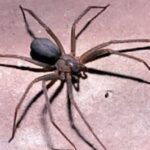Although I have owned a few different varieties of spiders as pets, I would not readily recommend keeping spiders to the average person. They are not specifically safe, and do require patience, understanding, and an earnest interest to keep as pets. Furthermore, I would not recommend spending money on a spider, as they can easily be found in the wild to be captured and observed as pets, and thus can be re-released into nature if needed. These are the best species that I have captured, or owned as pets.
5.) Grass Spider
Grass spiders are awesome to observe in the wild, and in captivity. They weave large matted webs along the tops of grasses, with tunnel-shoot entrances. They are harmless spiders, but their venom causes rapid paralysis in their prey, so their feeding is also interesting to observe. They will weave large webs in captivity, so I recommend a larger cage, although they are not large spiders. The grass spider’s webs lack the ability to catch prey, but they make up for that with their fast running, as they catch their pray in this manner. Also easily found in nature, I would recommend looking for one to bring into captivity as opposed to buying one.
Age: 4-7 years
Size: 1-3 inches
Tank Size: 15-20 gallon
4.) Wolf Spider
The Wolf Spider is the most common spider in the North American region, and this is why I recommend it as a pet. It is the easiest spider to find, capture, and observe in captivity, as they can be found nearly anywhere. It is the first spider I would recommend as a pet that is not a tarantula, as their venom is virtually harmless to humans. They leave a small itchy red swollen area much like a mosquito bite, if bitten. They eat moths, ants, and other small insects, and are easily kept in a cage. They don’t normally grow very large, and live around a few years, so are quite easy to keep as a pet without much commitment, and are easily adaptable and can be released back into nature if you cannot, or do not want to care for them any longer.
Age: 5 years
Size: 1-3 inches
Tank Size: 10 gallon
3.) Mexican Redknee Tarantula
This is one of the more regularly noticed tarantulas, as it has a distinct color and appearance. They have a darker body, with orange to red stripes that appear on or near their leg joints, thus giving them their name. They are very docile, fairly large, and believed to be on of the longest-lived Tarantulas. Males live shorter than females, though, females between 20 and 40 years old! What an incredible age for a spider. They are carnivores, and eat the same foods as most tarantulas, ranging from bugs to pinky mice.
Age: 15 male 20-40 female
Size: 6-7 inches
Tank Size: 20-25 gallon
2.) Texas Brown Tarantula
The Texas Brown is so common in the southwest, that if you live in Texas like me, you can walk outside at night and generally find one. They are similar to the Chilean Rose, with more brown color. They can weigh up to three ounces, and generally are a bit smaller than the Chilean Rose. They generally eat beetles, cockroaches (awesome!) and pinky mice. They are great pest controllers, and I love to see them around outside, because I know they are getting rid of things I would rather not see in my house. They are interesting, because they can lay over a thousand eggs in their nest. They are also easy to handle, and are not extremely defensive.
Age: 10-15 years
Size: 4 inches
Tank Size: 15-gallon tank
1.) Chilean Rose Tarantula
The Chilean Rose Tarantula is the most popular spider used for pets, and is the easiest to take care of. A large population of them were caught in the wild in Chile and shipped around the globe for use as pets, especially in the U.S. They are the least venomous of tarantulas, handle fairly well (remember, you are handling a spider), and eat simple foods such as crickets, mealworms, small insects. They are fascinating to look at, as they have large hairs, and can grow fairly large. They can live quite a long life as well, making them a very popular pet. These are also cheap, running between $10 and $30.
Dangers: Like all spiders, the tarantula has special hairs that can be shot out and released from the body on the underside of their belly. This is an innate action that can cause damage to eyes, if they are lodged into the eye. I recommend using eye protection when handling these spiders
Age: 15-20+ years
Size: 2-6 inches
Tank Size: 15-20 gallon tank
Now go outside and find some cool spiders! Be safe!




